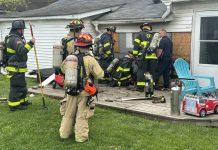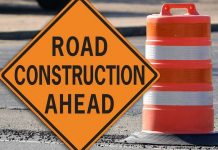Construction work on Rocky Ford Road has been completed, bringing a sense of relief and satisfaction for residents in the area who have coped with disruption for nearly two years.
The $6.3 million project stretching between Taylor and Talley roads on the north side of Columbus opened to traffic the day before Thanksgiving, said Dave Hayward, executive director of public works/city engineer.
Residents said they were thankful of that, with Hayward saying he appreciated the public’s patience as the final section of improvements on the former county road took shape.
Work on Rocky Ford Road between Taylor and Talley roads had been under construction since February 2016. The completed project resulted in three lanes for vehicular traffic, bicycle lanes and new curbs, gutters, storm sewers and sidewalks for the area.
[sc:text-divider text-divider-title=”Story continues below gallery” ]
Several pedestrian crosswalks, including one with flashing lights to alert drivers near Par 3 Drive and Highview Way, have been installed as well.
Rocky Ford Road has become a major east-west thoroughfare on the north side of the city, running from Washington Street to the west to Talley Road to the east, which encompasses more than 3 miles.
The latest Rocky Ford project was the fourth phase of work. Earlier phases included improvements to sections between Central Avenue and Taylor Road, Hayward said. The first three improvement projects widened Rocky Ford Road to four traffic lanes and added turn lanes at major intersections.
Temporary striping along a 2.5-mile stretch of Rocky Ford Road from Central Avenue to Talley Road was completed Monday as part of the project’s final steps, Hayward said. Permanent striping will be completed in April or May, he said.
Longtime residents have actually been impacted by work on Rocky Ford Road for more than two decades.
The Rocky Ford project began in 1994 under former Mayor Robert Stewart as population in the area was forecast to grow, along with traffic volumes. The road was designed to be a four-lane street, with two lanes of travel in each direction. But development in the northeast portion of the city slowed and traffic volumes fell short of projections, Hayward said.
Rocky Ford Road from Central Avenue to Taylor Road was four lanes until 2011, when the city went in a new direction and began reconfiguring it as a three-lane road, Hayward said.
Rocky Ford Road is still four lanes from Central Avenue to Taylor Road, but will be re-striped to make it three lanes in the spring, Hayward said.
What neighbors say
Homeowners who live along the updated project area — 80 percent of which are being paid by the federal government — said the improvements will be good not only for motorists, but for pedestrians as well.
“What we got in return for it was very well worth it,” said Cathy Pavey, who lives on Greenbriar Drive in the High Vista subdivision with her husband Steve.
Pavey, who has lived in her home for 29 years — before the first widening began, said installation of sidewalks and crosswalks will make the area much safer for children who attend Richards Elementary School nearby.
“That will be a blessing,” she said.
In addition, the sidewalks will give the public better access to the area on foot, said Pavey, who stressed that wasn’t the case before.
“It was almost like a death trap when you walk on Rocky Ford Road,” Pavey said.
In fact, a Columbus pedestrian sustained fatal head injuries in December 2014 after being hit by a vehicle as she was walking south across Rocky Ford Road near the intersection with Candlelight Drive, west of the area included in the fourth phase of road construction.
Pavey said she was glad to see the improvements, even though it was a long time coming.
“It was frustrating, but it was well worth it in the end,” Pavey said. “It’s progress and we welcome the street being done.”
Becky Luckmann, who also lives on Greenbriar Drive with her husband John, also cited her satisfaction with the project’s completion.
“Thank heavens,” Luckmann said. “Having it open will be so nice.”
Luckmann said the work on Rocky Ford Road resulted in detours, with drivers making their way through her neighborhood and cutting to County Road 300N, known as Sawin Drive in the Columbus city limits, to get to their destination. That was a safety concern for her since she has several grandchildren, she said.
That prompted Luckmann to place orange plastic cones at the edge of her driveway to alert drivers traveling through the neighborhood that there were young children in the area.
Another homeowner just down the road also posted a red sign directed at motorists: “Drive Like You Live Here.”
Luckmann said she plans to take advantage of the sidewalks along Rocky Ford Road to enjoy walks with her two grandchildren when they visit from Hartsville.
“It would’ve been nice if it moved a little faster,” Luckmann said.
“It was worth the wait,” she said, however. “I’m glad it got finished before the holiday.”
Luckman provided one takeaway from the experience.
“You have to be patient,” she said. “That’s one thing I’ve learned is that you can’t control what other people do.”
[sc:pullout-title pullout-title=”Project timeline” ][sc:pullout-text-begin]
1994: Rocky Ford Road improvement project between Central Avenue and Talley Road begins under former Mayor Robert Stewart, starting with widening of Rocky Ford Road at Central Avenue — followed by additional phases at different sections of the road in subsequent years.
2011: City revises design of Rocky Ford Road due to traffic studies which don’t support four travel lanes from Central to Talley roads. The section between Taylor and Talley roads was redesigned to make it a three-lane road.
2015: Right-of-way purchases are made from 35 property owners to widen the road, and final construction plans are completed.
2016: Work on fourth phase of improvements begins in February after awarding of contract.
2017: Construction work continues into 2017; Rocky Ford Road reopens to the public on Nov. 22.
Source: City of Columbus
[sc:pullout-text-end]




